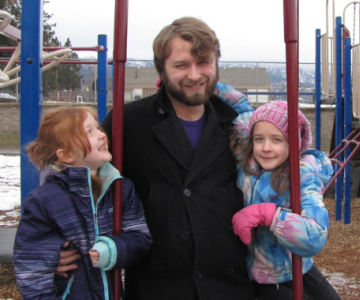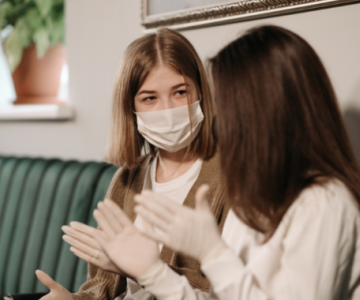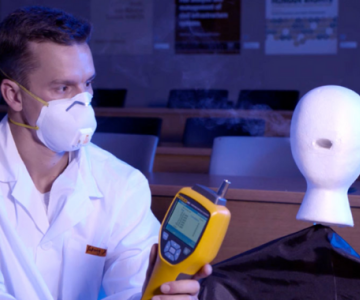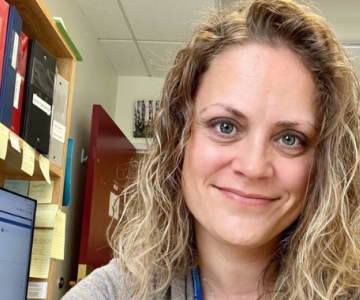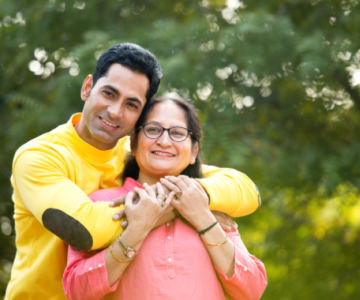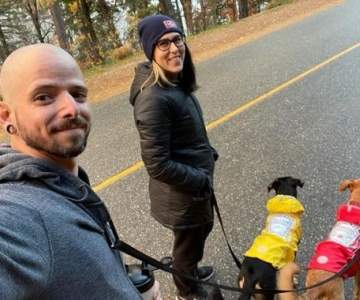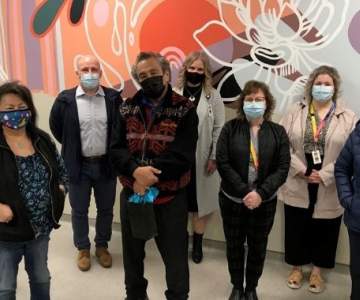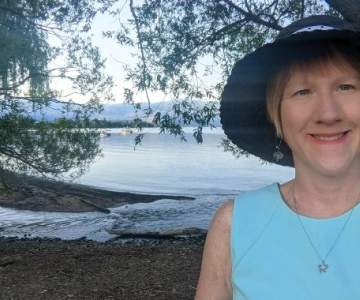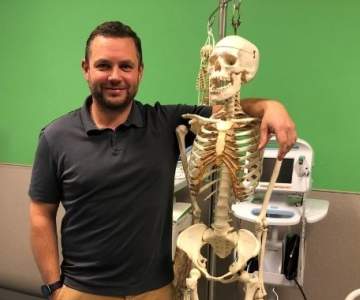Breadcrumb
Explore Stories
Health & Wellness
A few weeks ago I took my daughters for their first COVID vaccine. It was a day I'd been looking forward to since vaccines first became available, and my wife and I were relieved to be finally able to provide our girls with more protection from this virus.
As any family with young children can attest, raising kids during a pandemic is stressful. It was more stressful before the children’s vaccine was available and it will be even less stressful after they get their second shot.
The restrictions have made our lives more complicated. And I'm feeling frustrated - with this virus and with those who don’t follow the health recommendations designed to keep the rest of us safe.
"Many of us have heard Omnicron may be 'less serious', but
we can't bring our guard down. People are still getting very sick
and dying from this. We already know that more health-care workers
are becoming ill and our health systems are struggling to care for
so many additional people."
The way I see it, I wear my mask, get vaccinated, social distance, etc. not only to protect myself and my family but also to protect my friends, and the people of my town. It is a small inconvenience to do these simple things to help protect everyone.
Helping your kids get a COVID-19 vaccine
When we told our kids about their upcoming vaccine, they had different reactions. My eldest child was calm and accepted it easily. She understood why she needed the vaccine and that it was helping everyone else. My younger child didn’t understand why she needed a vaccine - she was too overwhelmed at the thought of getting a needle.
When the day finally came for their vaccines, I was really impressed with how organized and supportive the staff at the clinic were.
I noticed right away that the health-care workers spoke directly to the children, rather than over them and to me. And when my youngest was upset and crying prior to the vaccine, they made suggestion (remove her coat, have her sit on my lap) to get her shot with the least amount of stress.
Afterwards, my kids got stickers, colouring sheets, and candy canes. When we were waiting the 15 minutes to leave, someone came by with sticky notes for the kids to put on positive messages for other children. My daughters liked doing that.
My advice to other parents? Get yourself and your kids vaccinated! It's the best way to keep your family safe.
About the author
Kirk Warkotsch lives in Kelowna with his wife and their two daughters.
Health & Wellness
Even helpers need help sometimes.
When I first arrived in Kelowna last year, the magnitude of the change in my work life and home life hit me pretty hard. Although it was a positive change for me, I realized in pretty short order, almost everything about this big new role in a new city was getting harder and harder.
Zoe, a Kelowna Mental Health team member, finds getting out in nature good for her mental wellness.My colleagues were noticing I wasn’t at my best and let our manager know.
I am so grateful for how skilful and kind my manager was. At times they shared stories about their own difficult times, and it really set my mind at ease. The relief I felt energized me to level up my self-care and get back on top of my stress.
Even though I’m a therapist by training, I needed that reminder that I can’t DIY everything in life.
I needed someone to say, ‘I see you’re struggling.’ Beyond that, I needed to let some help in!
Why? Because that’s how the best help works: some self-help added to letting others in. It is a proven recipe for success.
If you’re looking for help for yourself or someone you’re close to, check out our mental health resources.
About the author
Zoe uses her training as a mental health clinician now for Interior Health project work in the Okanagan. She says the support of the colleagues around her made all the difference when she recently experienced her own mental health concerns.
Research & Innovation
By understanding airborne disease transmission, UBC Okanagan researchers are seeking new ways to break the chain of infection
AIRBORNE. AIRFLOW. DROPLET. AEROSOL. Since the arrival of COVID-19, these words have become commonplace, integrated into everyday conversations as quickly as the virus spread globally. But what remains unclear—and requires further study—is the role of airflow, droplets and aerosols in the transmission of COVID-19 and other infectious diseases.
That’s where a team of researchers from UBC Okanagan’s Airborne Disease Transmission (ADT) Cluster of Research Excellence come in. The group is dedicated to studying airborne diseases, with the overall goal of reducing the transmission of respiratory infections.
“What we’ve learned from the COVID-19 pandemic is how much we don’t understand about airborne disease transmission,” explains Dr. Sunny Li, research and development lead for the cluster and an associate professor in UBCO’s School of Engineering.
He points to the fact that people originally thought surfaces were the major transmission route for COVID-19, and then only later realized that it is mainly transmitted through the air. Dr. Li says airflow dynamics as well as the interaction between airflow and particles are complicated, and as a result the movement of particles is hard to predict. However, one aspect is certain; when it comes to understanding airborne transmission, size matters.
“Think about the dust particles you see dancing in the sunlight,” he suggests. “Because they’re large, they don’t move far and eventually fall to the ground. Viruses, however, are incredibly small and they can stay suspended in the air for a very long time, similar to how pollen stays in the air. They’ll travel with the flow of air and that’s how they spread disease.”
“If we better understand airborne disease transmission,
we believe we can develop technology to
reduce its spread and infection.”
At 0.1 micrometres (μm) in diameter the coronavirus is ten times smaller than a dust particle, which in turn is 10 times smaller than a white blood cell. Such particles with sub-micrometre diameters are referred to as aerosols, while larger liquid particles—which can carry smaller particles within them like viruses—are usually called droplets.
The lack of information about the spread and infectivity of these small particles spurred Dr. Li to bring together a team of researchers from UBC Okanagan and Vancouver, and the University of Toronto. With expertise in multiphase flows, computational fluid dynamics as well as health and technology innovation, the group have formed the ADT research cluster, an interdisciplinary network of researchers focused on solving key challenges facing society. Armed with new insights from experimental investigation, computer modelling, clinical trials and manufacturing, the research cluster hopes to scrub airborne disease from the air.
“If we better understand airborne disease transmission, we believe we can develop technology to reduce its spread and infection,” Dr. Li says.
“Our research needs to go beyond the lab and into real-world scenarios,” he adds. “Because some data is collected in a controlled environment, it may be misleading. We need both real-world and lab data because they complement each other.”
Dr. Li is working with ADT research cluster co-lead Dr. Jonathan Little from the School of Health and Exercise Sciences, along with Dr. Joshua Brinkerhoff from the School of Engineering to test experimental protocols in classrooms, hospital rooms and dentist offices. There are now some promising preliminary results.
Air scavenger for health and dental procedures
With the support of a Mitacs Accelerate grant, an early ADT cluster project tested an airborne infection isolation and removal (AIIR) device developed by CareHealth Meditech for use in dental offices. With a similar look to an old-fashioned hairdryer, the device was designed to isolate and eliminate airborne droplets generated during dental procedures.
“Many dental procedures generate aerosols, or small droplets that may contain infectious particles,” says Dr. Li. “The key to control transmission is to scavenge them locally before they circulate through the room.”
The initial lab experiment involved performing dental procedures on a mannequin connected to a breathing simulator. Fluorescent powder was applied to the mannequin’s teeth and mouth to track the spread of potentially infectious particles. Ultraviolet light was then used to visualize droplet and aerosol creation and dispersal, along with the dentist’s exposure to the simulated pathogen.
According to Dr. Li, early findings have shown that the AIIR device is effective at removing large droplets and aerosols. While it’s currently being used in some dentist offices, the cluster is exploring ways to improve the design.
“Our team is looking at the device’s size and geometry in connection with its airflow dynamics and the dynamics of droplets and particles to see if we can make units that are more accurate and efficient,” says Dr. Li.
Building on this experimental design, the next step of the ADT research cluster was to evaluate a scavenging hood in a health-care setting, in partnership with the Pritchard Simulation Centre team at Interior Health. Instead of sitting in a dental chair, the mannequin was placed on a hospital bed and exhaled glowing fluorescent particles while a tube was inserted into its airway. Researchers assessed the ability of an airflow dome to remove potentially infectious aerosols while the intubation was performed, and the ease of working around this new piece of equipment.
“So far our findings are encouraging,” says Dr. Little, the health lead of the ADT research cluster. “The dome device efficiently removed the tagged droplets and inhibited their spread. Now we’d like to see how it will work during different medical procedures and how comfortable the health-care team feels around it. Adding a new piece of equipment into an already crowded operatory or procedures room can be tricky.”
Dr. Jared Baylis, medical director of simulation for Interior Health and the UBC Southern Medical Program, is enthusiastic about this new simulation research and the opportunity to collaborate. “This is exactly what our program is designed to do. We’re well set up and have the practical expertise to run the experiments proposed by the ADT research cluster. We look forward to supporting more of their research.” He notes that this research and ongoing studies are made possible thanks to funding from the Colin & Lois Pritchard Foundation Student Enhancement Fund.
Dr. Little adds that although getting the right fit for these scenarios may take some time, “we need to figure this out,” so that life-changing procedures are not delayed by rising infection rates.
This story was originally published by UBC Okanagan's News. Read the full story here.
Community & Culture
Thea originally began her career with Interior Health six years ago as a Clerk/Receptionist in Williams Lake at Deni House, long-term care. Looking for a change in pace, she worked casual in Home and Public Health before becoming a Prevention Services Assistant in Public Health.
Thea, Her husband, and their four beautiful kids
One of Thea’s proudest career moments has been her time assisting the Williams Lake Thompson Rivers University COVID-19 Mass Vaccine Clinics. She collaborated with nurses, admin, security teams and Red Cross volunteers to keep the clinics running smoothly. Her co-workers inspire her daily through their positivity and willingness to help.
“Becoming the keeper of the vaccine has been a challenging role in the ever-changing pandemic, but I enjoy the behind-the-scenes work that keeps me on my toes.”
Being born in B.C. and growing up in the West Chilcotin has allowed Thea to enjoy an active outdoor lifestyle year-round. When she’s not working, Thea loves kayaking on the lakes, hiking in the mountains, kickboxing and doing mud runs.
Thea enjoying one of her favourite activities, kayakingAbove all, getting to spend time with her family and friends is what she enjoys the most. Recently there has been an exciting addition to Thea’s family as she has welcomed the arrival of her first grandchild!
We are IH is a recognition campaign to spotlight Interior Health employees and medical staff – through pictures and stories.
Name: Thea Telford (She/Her)
Job Title: Prevention Services Assistant (Vaccine Clerk)
Years of Service: 6
Worksite: Public Health
Community: Williams Lake
Ancestral Territory: Secwepemc
Advice to live by: Everyone is fighting a battle you know nothing about. Be kind. Always.
To keep the We Are IH loop going, Thea nominates Erin Domenko:
“Erin Domenko always goes above and beyond in everything that she does. She is always willing to help, no matter what needs to be done and her dedication is second to none.” –Thea Telford
Stay updated with careers at Interior Health
Facebook | Instagram | LinkedIn
Health & Wellness
Becoming a caregiver can creep up on you. Maybe it starts with dropping by your mom’s house to do her laundry or taking your dad to a doctor’s appointment or delivering groceries to your friend. Maybe you call your adult daughter every day to check in because she suffers from depression. Gradually, you find yourself doing more and more as the person you are caring for needs more support. You may not even realize it; you are making a commitment to care for someone else.
Other times, caregiving is triggered by a major health event or acute diagnosis, such as a serious fall, motor vehicle accident, stroke, heart attack or cancer diagnosis. Life as you know it shifts, and all your energy goes to caring for the person who needs you. In an instant, caregiving becomes your new normal.
People new to caregiving often feel:
they don’t know what they don’t know
overwhelmed by information and trying to sort out who their care providers are
unsure of what resources or programs exist for the person they are caring for
Caregiving doesn’t come with a crystal ball.
Given the complexity and ever-changing role of caregiving, caregivers often feel better when they are prepared and supported. The first stages of caregiving can feel like the most challenging. Caregivers often feel uncertain about the future, and feel the least informed about what’s happening, what’s needed and expected.
Finding the right information is a first step. This often includes:
Getting the best possible diagnosis. It may take a lot of calls, tests and appointments with the family doctor and specialists, but caregivers and the person they are caring for find it helpful to know what disease they are dealing with and what symptoms to look for.
Determining what supports you need. It can be time consuming to find the supports you need, but it is a very important step. Supports can include information, emotional support, and access to publicly-funded or private resources. Try to think about the specific types of support you need. For example, if the person you are caring for had a stroke, you may need more information about aphasia, the type of stroke, how it affected the brain, mobility and communication, and rehabilitation available in your community.
Learning new skills. Depending on the diagnosis, you might need to learn new skills to care for your loved one. Start by asking your health-care team. Disease-specific programs and caregiver support are also helpful. For example, you may be faced with a complicated medication regime or a rehabilitation program or transferring someone from a wheelchair to a bed.
Although it may seem overwhelming at first, there are lots of resources to help. A great way to get started is to check out Family Caregivers of BC’s Caregiver Learning Centre.
This story was originally published by Family Caregivers of BC
About the author
Wendy Johnstone works with Family Caregivers of BC and has close to 20 years of experience working with family caregivers. She provides one-on-one coaching and helps caregivers to build their skills, understand the resources available to them and gain confidence in their important role.
Health & Wellness
I first experimented with tobacco as a kid. My mom and step-dad smoked at home all the time, so it felt like a natural thing. I hated it at the time, but as I got a bit older I discovered Indonesian clove cigarettes. My friends and I liked their smell and sweet taste and they became our "party cigarettes".
Over time I switched to regular cigarettes because they were cheaper. And by the time I was 16 I was smoking a pack of cigarettes a day.
“Looking back, I realize I was struggling with anxiety.
I didn't know it at time, but I knew when I smoked I felt better.”
On New Year’s Eve of 2013, my wife suggested we both quit smoking the next day. I was all for it, but it actually took me years to successfully quit.
I really wanted to quit but wasn't sure I was ready. A year later I had cut down a lot, but I still smoked occasionally when I felt stressed out. My mom's health had really started to suffer because of the habit and I wanted better for myself and my wife. But I still relied on cigarettes when I felt anxious.
“Understanding that I was using cigarettes to manage my anxiety
helped me to finally kick the habit years later.”
Over the next few years I really cut back and had periods of not smoking at all. I didn't want to smoke anymore and didn't want to use cigarettes to deal with stress. I started looking for help to quit and tried nicotine patches, gum and vaping.
Vaping ended up making my addiction worse because of how convenient and accessible it is compared to cigarettes.
Nicotine spray is what eventually helped me get through the cravings.
In early 2021 I finally became smoke and vapour free. I've been learning how to deal with my triggers (stress and anxiety) in other ways, and I've also found I can't stand to be around cigarette smoke.
My physical and emotional well being has really improved since quitting. But the thing I'm most proud of is taking this step so I'll be a positive example in my family. When I have kids some day, I don't want them to have a parent who is a smoker and give them the bad example that I had at home. That was the reason I was introduced to cigarettes in the first place.
It took almost eight years after I promised myself and my wife to quit, but it's finally happened. And I think this time I'm not going back.
About the author
Marcel lives in Nelson in the traditional territory of the Ktunaxa, the Syilx, and the Sinixt peoples. He is 37 and works as an IT project technician.
Are you ready to make a change?
Changing behaviour is an individual journey but the right support can make all the difference. Here are three ideas to help get you started:
Get informed and find out about supports available to help you by checking out our Tobacco and Vaping resources.
If reducing or quitting smoking or vaping is on your 2022 list, speak with your pharmacist about the BC Smoking Cessation Program.
Share your journey to quit or reduce tobacco use or vaping and inspire others to achieve their goals. Email us to get started.
Health & Wellness
Within the non-descript walls of a clinic in downtown Kelowna, a health-care team is doing amazing things.
The Outreach Urban Health clinic includes family doctors, nurse practitioners, registered nurses, and social workers. They collaborate with mental health and substance use clinicians who are all working at the same location, to support a range of people, including those who are homeless, those dealing with mental illness, people with problematic substance use, as well as people without access to traditional health-care services, such as new immigrants.
“We are very proud of the new Outreach Urban Health site and the care that is being provided to some of the area’s most vulnerable people. Bringing over the primary care team from the original clinic on Leon Avenue and adding mental health services means that clients are now able to access care for all of their health needs within one location. This is having a really positive health impact for many of the people we see,” explains clinical operations director Danielle Cameron.
“Our goal was to create this new space to be bright and inviting, where health-care providers can offer culturally sensitive, inclusive, trauma-informed care to anyone that needs and wants it. Our teams continue to build trust with new and existing clients and the surrounding neighbourhood.”
The team at Outreach Urban Health offers a wide variety of health-care services. From giving COVID-19 vaccinations, writing and renewing prescriptions, providing vital specialist referrals, offering education on safer injection techniques for a person who uses drugs, or ensuring a client has shoes to wear, their services run the gamut - but their commitment to the population they serve is singular.
Since opening in March 2021, Outreach Urban Health has provided more than 3,000 appointments.
“This is a comprehensive medical centre offering a full suite of services to those most vulnerable in addressing both mental health and addictions. Our community is fortunate to have a facility such as this," said City of Kelowna bylaw services supervisor Ken Hunter after a recent tour of the clinic. "Interior Health has really stepped up to the plate here and there should certainly be focused community awareness to this – it truly is a good news story.”
Much of the care team’s efforts are focused on establishing familiarity and trust with clients. For example, a young street worker with multiple chronic illnesses and significant substance use issues was very nervous about accessing the health-care system, even though her health was rapidly failing. After one mental health and substance use worker invested time getting to know her and building trust, he was able to encourage her to connect with the primary care team. That young person became a regular patient, receiving much needed medical attention. She has left behind life on the streets, has a full-time job, is no longer using drugs, and her health issues are under control. This story demonstrates the impact of the care team’s collaborative, “one-stop-shop” approach.
It’s an approach that benefits many different types of clients and patients. For example, Devon is a peer worker who provides overdose prevention and harm reduction supports to those living in shelters and supportive housing. He finds the new location a great improvement for several reasons including the inclusion of supervised consumption services on site.
“The indoor supervised consumption site is much more functional for the staff and the patrons. I also have my doctor there, so it’s a one-stop-shop,” he says. “Supervised consumption is a service that’s really needed, especially in the downtown area. It’s not a matter of enabling people or encouraging them to use drugs. It’s about providing a place where people can go to use their drugs and know that they won’t die, instead of using in an alley all alone. It’s there to save lives.”
Learn more about Outreach Urban Health.
Photo above: Interior Health staff and community members gathered with Westbank First Nation elder Grouse and Edna from the Friendship Centre, to mark the opening of the newly relocated Outreach Urban Health clinic in spring 2021.
Community & Culture
Dr. Amanda Wilmer is no stranger to the B.C. Interior. While she was born in Vancouver, Amanda grew up living in Squamish, Williams Lake, Kamloops and Grand Forks, all before the age of 18. Amanda moved back to Vancouver to complete her formal education at UBC, but was delighted to have the opportunity to return to the Interior after finishing her training – having family in the area makes it feel like home.
Amanda is always willing to do whatever it takes to ensure high-quality care is provided to patients. For her, it’s been meaningful to come back to the Interior as a Medical Microbiologist at Kelowna General Hospital (KGH).
“It’s a pleasure to work with the rest of the laboratory team, who are similarly quality and patient care-oriented, to improve access to testing for all patients across IH.”
When Amanda first came to IH, no molecular testing was available for diagnosis of viral infections, such as influenza, and patients were waiting up to five days for results. Through collaboration with the KGH and Colin and Lois Pritchard Foundations, the KGH lab obtained the needed testing equipment.
“Through KGH Facility Engagement funding, my team was able to validate the equipment and our proposal was approved for trial funding of respiratory virus testing at KGH lab in winter 2017. The trial was successful, and testing was subsequently expanded to all microbiology labs region-wide. This infrastructure was key to the ability of labs to quickly adopt testing for COVID-19.”
Amanda describes herself as ‘energetic,’ and seeing her love for water activities drives that home.
“I love spending time on the water. Whether it be paddle boarding, kayaking, wake surfing, scuba diving or just floating – the water is my happy place.”
Amanda also enjoys hiking and snowboarding. She and her husband, James, spent as much time as possible leaving the city when living in Vancouver, so coming back to the outdoor playground of the Interior has been amazing.
Despite loving where she lives, Amanda is also looking forward to travelling again.
“I love visiting new places, experiencing new cultures, trying new foods and enjoying beautiful scenery. Before COVID-19, I travelled a lot, and am hoping to continue these adventures once things settle down!”
To keep the We Are IH loop going, Amanda nominates Hope Byrne
“Hope Byrne is an amazing person, but also an outstanding leader who has been so instrumental in improving patient care by ensuring the best laboratory services are being provided in IH. She has worked tirelessly (often days, nights and weekends) during the COVID-19 pandemic to ensure the lab is able to provide timely and high-quality results. She also serves as a mentor and inspiration to many others in the laboratory, and somehow finds time to also do her MBA!” – Dr. Amanda Wilmer
We are IH is a recognition campaign to spotlight Interior Health employees and medical staff – through pictures and stories.
Name: Dr. Amanda Wilmer (she/her)
Job Title: Medical Microbiologist
Years of Service: 7
Worksite: Kelowna General Hospital
Community: Kelowna
Ancestral Territory: Syilx Okanagan
Favourite Quote: I can't change the direction of the wind, but I can adjust my sails to always reach my destination.
Stay updated with careers at Interior Health
Facebook: Interior Health | Instagram: interiorhealthbc
| LinkedIn: Interior Health Authority
Research & Innovation
Dr. David Cruickshank is an orthopedic surgeon at Royal Inland Hospital who is part of the team who is now able to send patients home with hip and partial knee replacements on the same day as their surgery. His skeleton pal helps the orthopedic surgeons educate patients on their joints.
Years of intensive equine riding events and weightlifting took a heavy toll on Shelby Roblin’s knees – so much so that she has lived with pain for the past 10 years.
When the COVID-19 pandemic forced the postponement of elective surgeries across B.C., she expected she would be waiting a lot longer for relief.
Instead, thanks to innovative planning and two enthusiastic surgeons, she got her long-anticipated partial knee replacement in December at Royal Inland Hospital in Kamloops.
Now she is looking forward to the second procedure, particularly because she knows that once again, no overnight stay will be required.
“My surgery was in the morning; I saw the physio at one and I left the hospital at 2 p.m.”
Shelby has been in hospital before when she had to stay for several nights and “it was not very pleasant.”
So when her orthopedic surgeon Dr. Chris Dusik told her she would be able to sleep in her own bed the night of the surgery, she was ecstatic.
Shelby Roblin was thrilled to get a partial knee replacement in early December and even happier to find out she was going home the same day.“Dr. Dusik did a fantastic job. I have had no pain or infection. I slept well and was up walking about in the morning. I would recommend going home that day to anyone who fits the criteria. It is just so much better for recovery,” said Shelby.
She added that because the hospital did not need to find a bed for her, she was able to get in for her surgery much sooner. Seven days after her surgery, Shelby was still glowing about her short hospital stay and the success of her knee replacement.
As a patient, Shelby met the criteria for the program. She is 51 and had her adult son at home to provide some support during the recovery period. Basically, suitable patients must be fairly young, reasonably healthy and have someone at home to help them.
Until recently, all patients getting hip, knee or shoulder replacements stayed in hospital a minimum of one night.
Dr. Dusik and his partner Dr. David Cruickshank proposed the idea of a day-care joint program for their patients as a solution to a difficult problem for people who had been waiting years, often in pain, for orthopedic procedures.
The team started with hip replacements, moved into partial knees, with shoulder replacements coming next.
The results have been “incredibly successful,” with virtually no complications, said Dr. Cruickshank. He said patients are overwhelmingly positive about the experience. When the surgeons check in with them the next day, they are all rested and up using their new joints with minimal pain.
Both surgeons are looking forward to broadening the program to include more patients once more physio resources are available.
“Expanding the program would mean the ability to complete significantly more surgeries in the context of bed shortages. Ultimately, this would translate into shorter wait times and decreased health-care costs,” said Dr. Dusik.
There’s no reason not to expand when the cost savings and positive feedback from both patients and providers are considered, added Dr. Cruickshank.
Denisa Urban, who works in surgical process improvement in Kamloops, credits the surgical improvement team for creating something really positive during the challenging circumstances of the pandemic.
“We have a very dedicated multi-disciplinary team who is keen at preserving patient safety and satisfaction. The results are due to a really fantastic team who came together to achieve a common goal,” she said.
Dr. Tyler MacGregor, perioperative medical director at Royal Inland Hospital, performs most of the orthopedic procedures in Williams Lake and said patients are extremely grateful for the new program.
Bonnie Markland was the first patient at Cariboo Memorial Hospital to have her surgery in the morning and head home the same day. Dr. MacGregor proposed the idea for her hip replacement, noting she was a prime candidate.
It also appealed to her because it meant she would have surgery earlier given she wouldn’t need to stay overnight in hospital.
“I had been living in pain for about four years so I was willing to do that. I was a little nervous about how the pain would be managed, but it worked out fine. I would highly recommend it. It was great to be able to have the surgery locally and go home to my own bed.”
Same-day joint replacement surgeries also take place at Kelowna General, Penticton Regional, and Vernon Jubilee.
-
Load More
Showing 513 of 786
Sign up for email updates
Receive news, alerts, public service announcements and articles right to your inbox.


